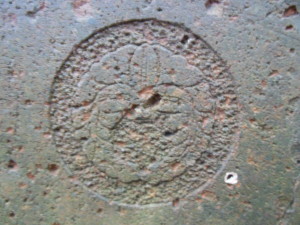Family crests are usually a lot less impressive than we might first want to imagine. Nevertheless, they can still reveal interesting things about your family. When I was a kid, for example, my great aunt used to make a big deal about the Helm family crest. She would tell the story of how sometime back in medieval days, a Helm was honored by his prince for sending his seven sons to battle under the prince. For that loyalty, he received the family crest that hows seven helmets on a shield.
The black and white image shows the family crest as depicted in family documents. The one in red is a version drawn by my cousin, Alan Webster.
When I was about fourteen, in a surge of family pride, relatives had a mold of the family crest made and many of us received jewelry with the crest. My sisters received gold pendants with the mark of the crest, while my brother and I received rings and cuff links. I gave the ring to my son Eric when he turned 18. We Helms were in disarray and seemed to be in search of something to show we were important in some way.
At the beginning of my family search, I made some effort to determine whether there was any significance to the crest. I was very excited to discover that Trudy (Helm) Weber has a seal with the crest. The kind uses to press into wax to seal an envelope. The handle of the sea was a ruby-colored precious stone. I suspect that Trudy’s father, Karl, or perhaps my great grandfather, Julius Helm, had it made, although it’s possible that the seal may have been older. Perhaps one day someone will have it evaluated to determine its age. But whatever it’s age, I’m pretty sure it doesn’t go back hundreds of years. I have serious questions as to its authenticity.
Why? Well, for one thing, the helmet at the top is a barred helmet, which is reportedly used only for nobility.
![images[1]](http://lesliehelm.com/wp-content/uploads/2014/03/images1.jpg) Yet I have come across nothing to suggest we were ever remotely related to nobility. According to stories from my great-grandfather’s sister, Charlotte, the Helm family migrated from the Netherlands. An early story tells of an ancestor who was a pastor in Schleswig Holstein, on the border with Denmark. He apparently had a disagreement with his patron who was loyal to the Pope. Apparently, our pastor ancestor tore off his vestments, threw them on the ground and said angrily “There lies the Pope and here stands the church.” Presumably this story happened sometime around the Thirty Years’ War in the early 1600s, when Catholics and Protestants battled for control of the many principalities in Europe.
Yet I have come across nothing to suggest we were ever remotely related to nobility. According to stories from my great-grandfather’s sister, Charlotte, the Helm family migrated from the Netherlands. An early story tells of an ancestor who was a pastor in Schleswig Holstein, on the border with Denmark. He apparently had a disagreement with his patron who was loyal to the Pope. Apparently, our pastor ancestor tore off his vestments, threw them on the ground and said angrily “There lies the Pope and here stands the church.” Presumably this story happened sometime around the Thirty Years’ War in the early 1600s, when Catholics and Protestants battled for control of the many principalities in Europe.
The first record we have of the Helm line is of great, great, great-grandfather, Joachim Adolph Friedrich Helm. He was born in Mecklenburg, Trollenhagen and made his way to Woldegk in the north of Germany. There he studied law and became a law court administrator and church economist. We think he might have gotten that post in 1785 when he married Charlotte Dorothea Fuchs, the widow of his predecessor. The father of this widow was a superintendent in the region, presumably somewhat prominent. But the Fuchs were hardly nobles. Over the internet, someone recently connected to my family tree, which gave me access to the family background of the Fuchs. The occupations of two of the earliest people on the family register, which went back five hundred years, were listed as “assistant executioner.”
Joachim’s youngest son, my great-great grandfather, Johann Theodor Julius Helm, was born in 1800 and studied law like his father but ended up going into farming, because he suffered from terrible headaches when he read texts. Instead, he bought a 400-acre farm in Rosow, north of Berlin, where my great-grandfather was born in 1840. So in the case of the Helm crest, there is no evidence of how the family got the crest, and no sign of nobility.
When it comes to the Japanese side of the family, the family of my great grandmother Hiro Komiya, there are two crests.
In Japan, with the exception of some very prominent families, crests are relatively informal symbols. Anybody can choose just about any crest. When I first started research into my family, people told me the Komiya crest was the one above with the crossed eagle feathers. But when I met distant relatives, they told me the Komiyas had once been samurai and even had a castle. But the castle had long since been destroyed, and hundreds of years ago our branch of the family had renounced our samurai past to settle down as farmers. Their family crest was the wisteria crest shown above with the drooping flowers making the sides of a circle. I assumed we represented two different branches of the same family. Yet, there was a mystery. On the gravestone of my great-grandfather’s first daughter, who died as a baby, was the wisteria symbol shown below.
Yet, when if finally found the grave of my Japanese great-great grandfather, the grave had the symbol of the two crossed feathers.
At the time I wrote my book, Yokohama Yankee, I couldn’t explain the two different crests for the same family. I have since learned that it is not unusual for a new branch of a family to adopt a new crest. I believe that the family’s original crest was the wisteria crest since that was on a gravestone placed in 1875, when Caroline Helm, the first daughter of Komiya Helm, died as a baby. The second crest, the two crossed feathers, by contrast, was on the grave of a much newer grave for my great great grandfather’s adopted son. The son was adopted when he married my great-great grandfather’s daughter. In an unusual situation, the the biological daughter died, and the adopted son remarried. Since there was now no longer any blood connection with his adopted father’s side of the family, the adopted son appears to have decided to take on the new crest, the crossed eagle feathers. He had the crest with the crossed feathers put on his grave. His father in law’s grave is used, somewhat disrespectfully as one of the stones that support the foundation of the adopted son’s grave.
Crest’s are really only important if they mean something to the family. Although I have mixed family’s about my Helm ancestors and doubt they ever had noble blood, I came to love them in the course of writing my book. And while I’m not crazy about the martial theme of the Helm crest, it is tied to the family’s history. I hope my adopted son and daughter, who carry the Helm name, will also feel some connection to the Helm crest.
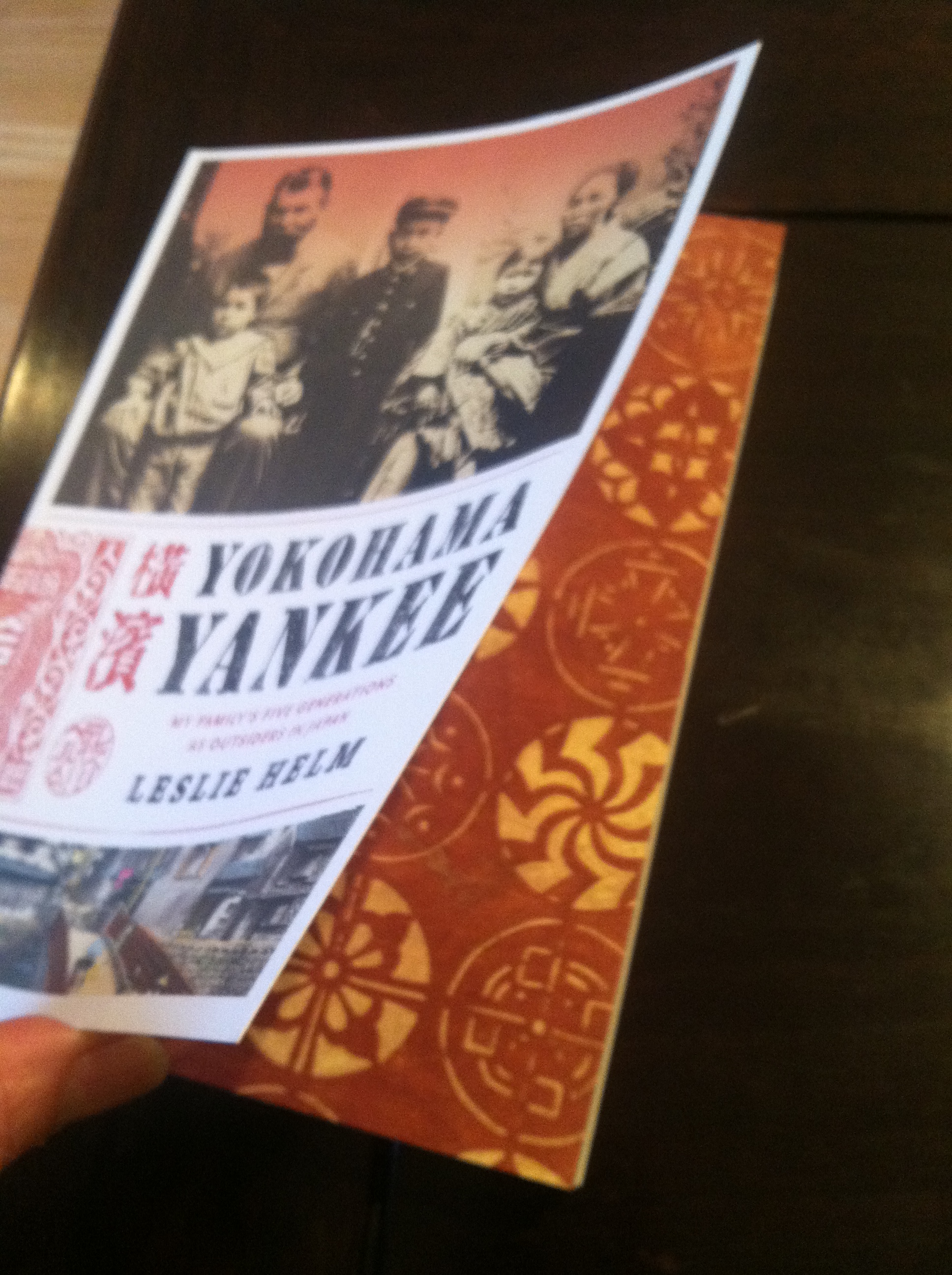
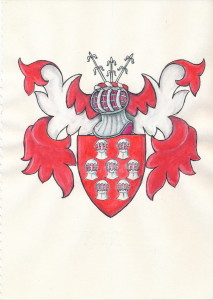
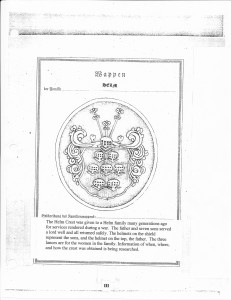
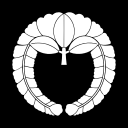
![176px-Japanese_family_crest_takanoha.svg[1]](http://lesliehelm.com/wp-content/uploads/2014/03/176px-Japanese_family_crest_takanoha.svg1_.png)
